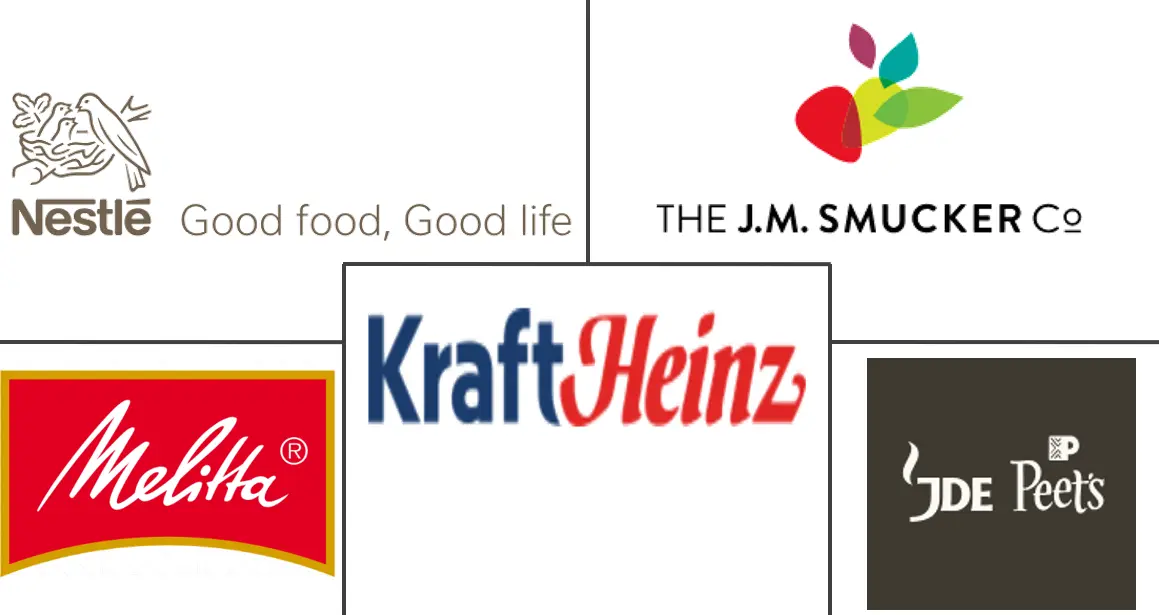Latin America Coffee Market Size and Share
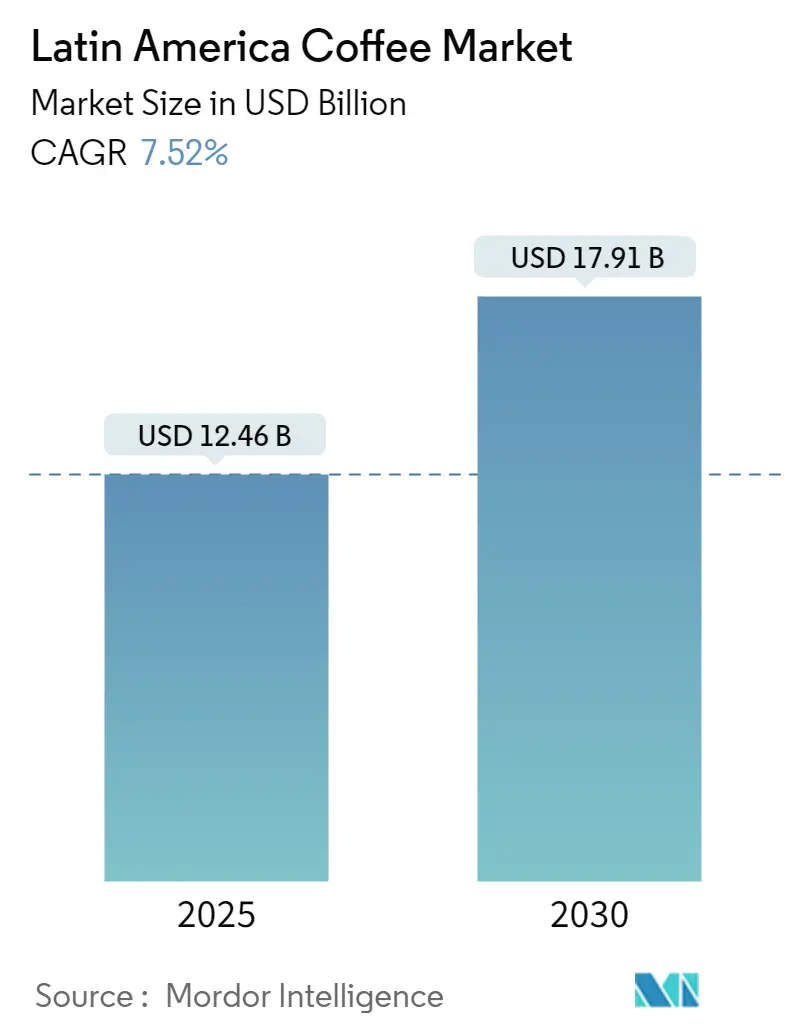
Latin America Coffee Market Analysis by Mordor Intelligence
The Latin America Coffee Market size is estimated at USD 12.46 billion in 2025, and is expected to reach USD 17.91 billion by 2030, at a CAGR of 7.52% during the forecast period (2025-2030).
The market is driven by multiple factors, such as the increasing demand for certified coffee products, consumer acceptance of single-serve coffee brew systems, and constant innovation in terms of flavors and packaging in the coffee market. The rising demand for instant coffee and more premium options for reasons of convenience, quality, and flavor is further boosting the market dynamics. Furthermore, drinking coffee at cafes, offices, and other food outlets among millennials and Gen Z is becoming the symbol of fashion and an opportunity to socialize. Hence, the rising popularity of coffee among millennials and Gen Z consumers is projected to fuel the growth of the Latin American coffee market.
Argentina has a strong coffee culture, with a tradition of consuming coffee throughout the day. This cultural preference drives demand for instant coffee as a convenient and accessible option for coffee consumption. For instance, according to the US Department of Agriculture, in 2022-23, the consumption volume of green coffee in Argentina amounted to 990 thousand 60-kilogram bags, up from 906 thousand 60-kilogram bags consumed in the year 2021-22. Furthermore, according to UN Comtrade, Brazil exported USD 7,350.81 million worth of coffee in the same year, ranking itself as one of the significant exporters of coffee. Market players seek to strengthen their presence in the market by incorporating coffee trends in their business operations, including innovative coffee pods, cold-brew coffee, functional coffee, premiumization, and marketing of key coffee brands. For instance, in February 2023, Starbucks Brazil opened three new stores in the Brazilian region. The stores are located at Fortaleza (Ceará), Goiânia and Alexânia (Goiás), and Recife (Pernambuco). Starbucks’ stores provide a wide range of coffee products, including ready-to-drink coffee beverages. The expansion of coffee chains in the region is expected to create growth opportunities for market players to offer premium and innovative products for the foodservice industry.
Latin America Coffee Market Trends and Insights
Rising Popularity of Ground/Roasted Coffee Driving the Market
Coffee culture is deeply ingrained in Brazilian society. Cafes and coffee shops are becoming popular social hubs, promoting the consumption of ground coffee. This cultural shift enhances the demand for roasted coffee as part of everyday life. Moreover, in 2023, the Ministry of Agriculture and Livestock established new standards for roasted coffee sold in Brazil, including mandatory information on labels, producer and retailer accountability for selling adulterated products, and the consumer protection agency’s action on complaints of product fraud.
The growing recognition of the health benefits linked to moderate coffee consumption is fueling the growth of roasted coffee. Antioxidants in roasted coffee help boost immunity, which can prevent cancer and other diseases. The rich brown color of coffee results from these antioxidants, which can help fight free radicals that cause cellular damage and have been linked to cancer. As a result, people who consume coffee regularly are at a lower risk for multiple types of cancer, including colorectal cancer. In 2022, according to the International Agency for Research on Cancer, the number of cancer deaths in Brazil included 38.29 thousand for lung cancer and 28.88 thousand for breast cancer. Thus, these advantages have shaped a positive outlook among regional consumers toward roasted coffee. Health-conscious individuals are on the lookout for roasted coffee items that not only deliver a delightful taste but also promise potential health advantages. Moreover, roasted coffee reduces the risk of cancer and enhances liver health. Consequently, the health benefits provided by roasted coffee are spurring consumption, ultimately propelling market expansion.
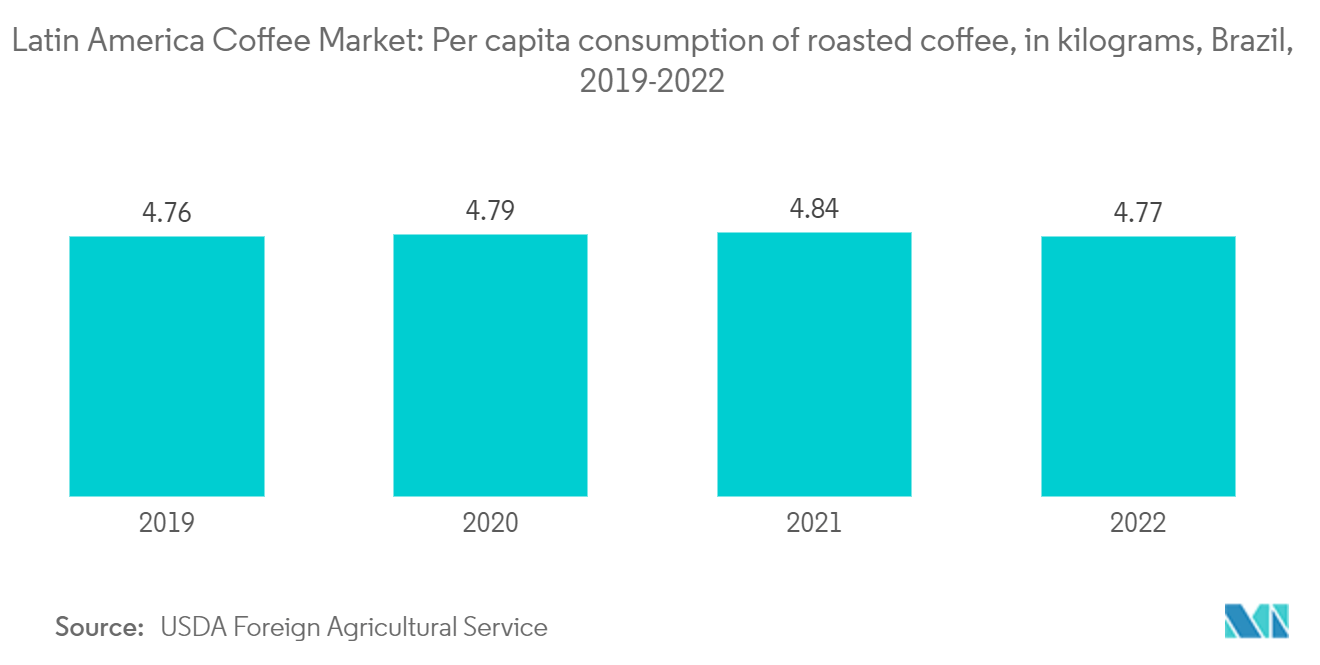
Brazil Holds a Dominant Share in the Latin American Coffee Market
Brazil's coffee culture is supported by an increase in the number of small specialty cafes and coffee shops. Factors such as the quality of coffee, along with the coffee brand, texture, temperature, milk, and the level of crema in an espresso, are highly important to customers. Brazil is one of the largest producers of coffee beans in the world. According to National Supply Company (Portuguese: Companhia Nacional do Abastecimento (CONAB)), in 2022, the revenue of coffee production in Brazil was USD 11.81 billion. Brazil is one of the largest coffee-producing countries in the world, and coffee consumption is deeply ingrained in Brazilian culture. As a result, the country has a high demand for coffee beverages.
In addition, factors such as sustainable coffee pods are of immense importance to Brazilian consumers. Due to this, manufacturers are more inclined toward offering biodegradable coffee pods. For instance, In November 2022, Nestlé launched sustainable coffee pods. Neo's new range of coffee pods are paper-based, home-compostable, and use 70% less packaging (by weight) than current capsules, as per the company’s claims. Such sustainable coffee pods drive the demand for coffee in the regional market. Furthermore, Brazilian consumers registered greater demand for roasted and grounded coffee over the study period. Coffee pod manufacturers in the country are constantly producing innovations in terms of flavor, variety, and price in order to increase their consumer base. Some of the popular brands of coffee pods and capsules available in the country include Lavazza, Rosso, Mokaccino, and Kimbo.
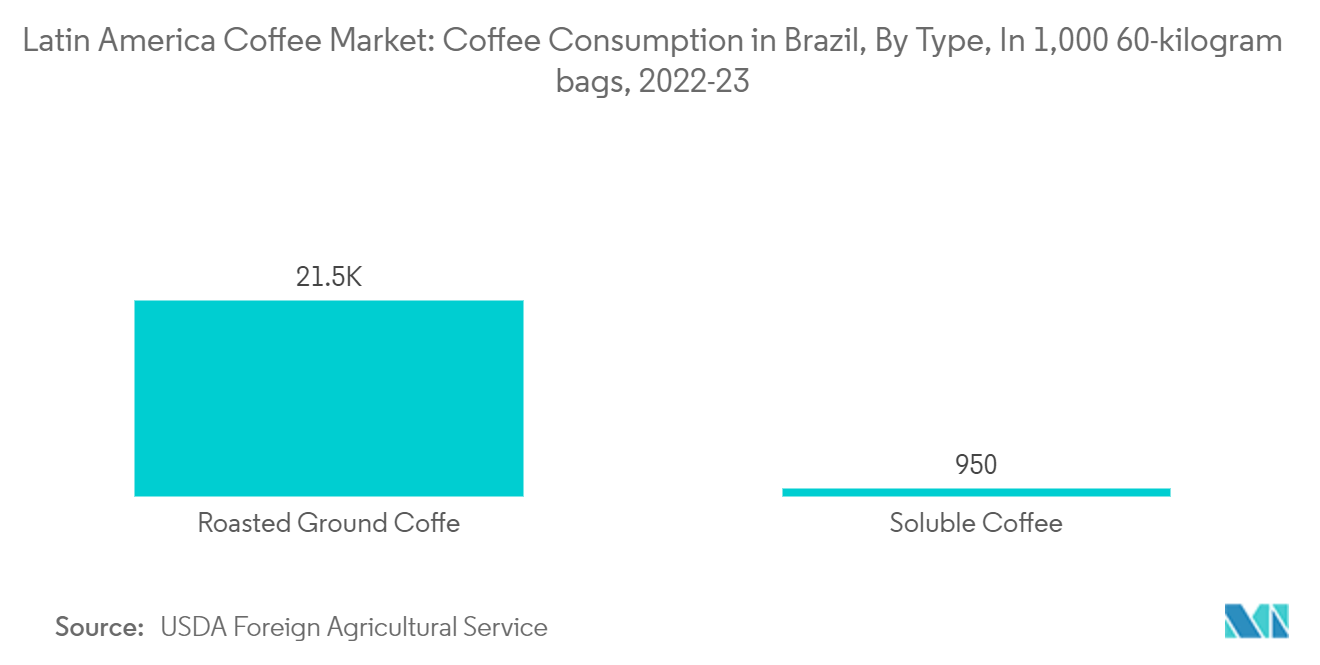
Competitive Landscape
The Latin American coffee market is fragmented, with the presence of numerous players. There are several prominent players in this industry, including Nestle, The J.M. Smucker Co., The Kraft Heinz Company, Massimo Zanetti Beverage Group, JAB Holding Company, Four Sigmatic, Luigi Lavazza SpA, Califia Farms LLC, Cedar Lake, and Garcomex SA de CV, which hold a significant share of the market studied. These players are embarking on business strategies, including product innovations, partnerships, strengthening their hold over online and offline marketing, and mergers & acquisitions to expand their visibility and portfolio of offerings, thus augmenting the growth of the market. For instance, in June 2023, Brazil’s "The Coffee" opened its first store in Peru in the upscale Lima neighborhood of San Isidro. The new San Isidro store also represents The Coffee’s shift away from small-format, on-the-go outlets toward ‘larger coffee shops.’ "The Coffee" currently operates nearly 200 stores in Brazil.
Latin America Coffee Industry Leaders
-
The Kraft Heinz Company
-
Nestlé S.A.
-
JDE Peet's N.V.
-
Melitta
-
The J.M. Smucker Co.
- *Disclaimer: Major Players sorted in no particular order
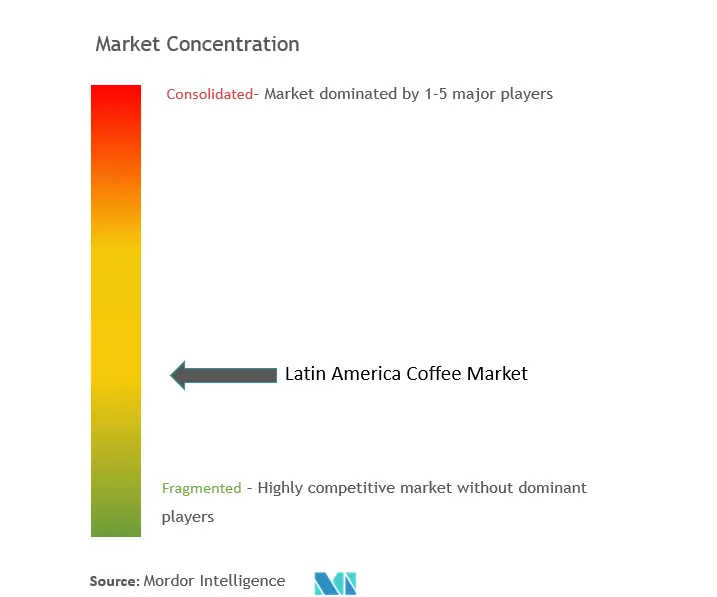
Recent Industry Developments
- May 2024: Nestlé announced plans to enhance its B2B and B2C operations in Brazil by investing BRL 1 billion (approximately USD 193.97 million) by 2026. The renowned coffee company aims to utilize this funding to implement advanced technology, such as roasting equipment, and enhance production line flexibility to introduce new products and flavors.
- February 2024: Nespresso Professional launched a Brazil Organic capsule, a new pure Arabica blend developed exclusively to complement the existing Origins Organic range. The new Brazilian capsule will join flavors from Peru, Congo, and Colombia as an addition to the collection. All four professional Origins Organic coffees are ‘Made with Care’ and sourced from carefully selected regions within their respective countries.
- January 2024: JDE Peet completed the acquisition of Maratá's coffee & tea business in Brazil. The acquisition complemented JDE Peet's’ existing portfolio of brands predominantly sold in the southern regions of Brazil and increased the company’s scale and national coverage in Brazil, a market that offers compelling prospects for both volume and value growth.
Latin America Coffee Market Report Scope
In Latin America, coffee is the most popular brewed drink prepared from roasted coffee beans, which are the seeds of a certain Coffea species.
The Latin American coffee market is segmented by product type, distribution channel, and geography. Based on product type, the coffee market is segmented into whole bean coffee, ground coffee, instant coffee, coffee pods and capsules, and ready-to-drink coffee. Based on the distribution channel, the market is segmented into on-trade and off-trade. Off-trade is further sub-segmented into supermarkets/hypermarkets, convenience stores, online retail, and other off-trade distribution channels. By geography, the market is segmented into Brazil, Argentina, and Rest of Latin America. For each segment, the market sizing and forecasts have been provided based on the value (USD).
| Whole Bean Coffee |
| Ground Coffee |
| Instant Coffee |
| Coffee Pods and Capsules |
| Ready-to-drink Coffee |
| On-trade | |
| Off-trade | Supermarkets/Hypermarkets |
| Convenience/Grocery Stores | |
| Online Retail | |
| Other Off-trade Channels |
| Brazil |
| Argentina |
| Rest of Latin America |
| Product Type | Whole Bean Coffee | |
| Ground Coffee | ||
| Instant Coffee | ||
| Coffee Pods and Capsules | ||
| Ready-to-drink Coffee | ||
| Distribution Channel | On-trade | |
| Off-trade | Supermarkets/Hypermarkets | |
| Convenience/Grocery Stores | ||
| Online Retail | ||
| Other Off-trade Channels | ||
| Geography | Brazil | |
| Argentina | ||
| Rest of Latin America | ||
Key Questions Answered in the Report
How big is the Latin America Coffee Market?
The Latin America Coffee Market size is expected to reach USD 12.46 billion in 2025 and grow at a CAGR of 7.52% to reach USD 17.91 billion by 2030.
What is the current Latin America Coffee Market size?
In 2025, the Latin America Coffee Market size is expected to reach USD 12.46 billion.
Who are the key players in Latin America Coffee Market?
The Kraft Heinz Company, Nestlé S.A., JDE Peet's N.V., Melitta and The J.M. Smucker Co. are the major companies operating in the Latin America Coffee Market.
What years does this Latin America Coffee Market cover, and what was the market size in 2024?
In 2024, the Latin America Coffee Market size was estimated at USD 11.52 billion. The report covers the Latin America Coffee Market historical market size for years: 2019, 2020, 2021, 2022, 2023 and 2024. The report also forecasts the Latin America Coffee Market size for years: 2025, 2026, 2027, 2028, 2029 and 2030.
Page last updated on:
Latin America Coffee Market Report
Statistics for the 2025 Latin America Coffee market share, size and revenue growth rate, created by Mordor Intelligence™ Industry Reports. Latin America Coffee analysis includes a market forecast outlook for 2025 to 2030 and historical overview. Get a sample of this industry analysis as a free report PDF download.
